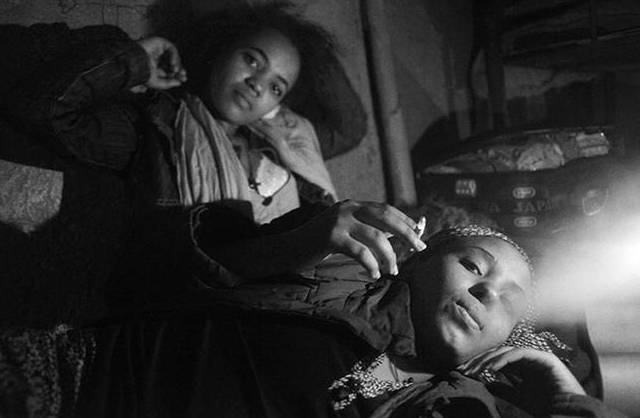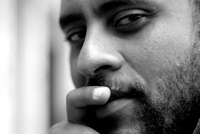 One of the images from a photography series by Michael Tsegaye called "Working Girls." It was taken in the Sebategna area of Addis Ababa. (© Michael Tsegaye)
One of the images from a photography series by Michael Tsegaye called "Working Girls." It was taken in the Sebategna area of Addis Ababa. (© Michael Tsegaye)
Tadias Magazine
By Tadias Staff
Updated: Friday, September 16, 2011
New York (TADIAS) – Addis Ababa does not have a Red Light District per se, but the Sebategna area in Merkato comes close to it. Photographer Michael Tsegaye’s intimate portraits of prostitues from this neighborhood, entitled Working girls II, is currently showing at a highly-regarded international exhibition in Paris dedicated to non-Western photography. He is one of 46 contemporary photographers from 29 countries whose work is on display through November 11th, 2011 at the 3rd edition of the Photoquai Biennale exhibition of world images organized by the musée du Quai Branly.
“I wanted to share what I saw, but ultimately everyone will have their own response to it,” Michael Tsegaye, who was born and raised in Addis Ababa, said in a recent interview with Tadias Magazine. “A lot of the women, as well as the customers, come from many different parts of the country, since it’s close to the central bus stop. This creates an interesting social dynamic.”
And how did he gain the women’s confidence for such a close-up look at their lives? “I spent about two weeks with them, spending the day in the room where they live,” he said. “The first three days were very quiet, until they got used to me. We spent a lot of time talking, eating meals together, drinking tea and coffee.”
Below is our Q & A with photographer Michael Tsegaye:
—
TADIAS: What prompted you to focus on this issue?
Michael Tsegaye: I had taken photographs of prostitutes in Sodo a long time ago, but then wanted to continue the project. I decided to try it in Addis Ababa since it is a very sensitive issue.
TADIAS: What do you want people to take away from these images?
MT: Whatever they’d like. I wanted to share what I saw, but ultimately, everyone will have their own response to it.
TADIAS: You say on your website that as a photographer you don’t want to be “pigeonholed.” What do you mean by that?
MT: It’s common for people in the art world to first define you as an Ethiopian or an African artist, as opposed to just an artist. Once you are labeled in that way, you are then easily exotified. You are not given equal stature with other international artists – -the Europeans, Americans etc. Your work is not judged on its artistic merit, or the idea it represents, but rather which continent it comes from.
TADIAS: How did you get into photography?
MT: It was by accident. I used go to the Geothe Cultural Center to use the library, and one day I came across a photography workshop that was being led by a German photographer called Ralf Becker. I sat in on the class, and he thought I was a student. Later, I walked up to him to ask questions and we started a conversation. He asked me to join the class, and I did. We are still good friends to this day. He bought me my first camera, a Minolta analog.
TADIAS: What is good photography?
MT: There is a quote by a Frenchman called Jacques Leenhardt. It says: “Photography is best when it emulates poetry”, portraying “… not only the complex and problematic reality of the outside world, but also the way a person’s eye has seen it. It shows a person’s self-expression, a person becoming the poet we all have within us…” I think this is a very true statement.
TADIAS: Do you have a favorite photographer?
MT: I dont have a favorite photographer, but I have favorite painters, like Vermeer, Rembrandt, and Repin. I like Vermeer and Rembrandt because they make good use of light, while Repin’s composition is a great example of Russian painting.
TADIAS: We understand that you too started out studying painting but later developed an allergy to oil paint? Can you tell us more about that and how it has impacted your artistic expression?
MT: Over time, the hours I had spent in the studio breathing in fumes from the oil paints made me very sick, which forced me to give up painting. I then switched to photography as my main medium of expression. In terms of its effect on my overall artistic expression, as a whole, painting and photography are very different disciplines. With painting, I spent a lot of time in the studio. But photography forces you to interact with people, to explore the country and what is around you. From painting, I learned how to use light and composition in my photographs, so it has made learning photography much easier for me. I try to photograph with a painter’s eye.
TADIAS: Regarding the photos in your latest exhibition, is there a reason why you selected the Sebategna area in Merkato?
MT: Yes. Sebategna is an area heavily populated with commercial sex workers. Since there are so many, over time the area has formed its own subculture. In Sebategna, you will find a diverse range of prostitutes: from the very inexpensive, to the more costly. They are also diverse in age as well. A lot of the women, as well as the customers, come from many different parts of the country, since it’s close to the central bus stop. This creates an interesting social dynamic.
TADIAS: How did you gain the girls’ confidence?
MT: I spent about two weeks with them, spending the day in the room where they live. The first three days were very quiet, until they got used to me. We spent a lot of time talking, eating meals together, drinking tea and coffee.
TADIAS: Any parting words?
MT: I’d just like to thank Tadias Magazine and urge the Tadias audience to continue supporting Ethiopian arts.
TADIAS: Thank you and wishing you continued success.
MT: Thank you very much.
—
Learn more about Michael Tsegaye at: www.michaeltsegaye.com.
Join the conversation on Twitter and Facebook.



























I like these photos because unlike other images of the same genre these are socially conscious. They say many things and speak volumes.
It will be interesting to see the contrast in background (poor, middle-class, rich) between high cost and low cost. Michael Tsegaye focuses on the poor backgrounds only, likely their families are often suffering hardship. …thus prostitution is the only way to make a living. But for others it could be a complimentary income.
The words that come to mind are sensitive, poverty, hardship, …I can see in their eyes the future is dark for these girls. why did the photographer choose black and white photos as opposed color photographs? I think color would have enhanced his point. Otherwise, well done!
It is the oldest profession in the world. Every city needs to have a red-light-district!
Excellent pics of the working girls in Addis Ababa. I know its popular with sex tourists but never been myself.
The photographer needs to visit Gonder, Ethiopia, enqkoye sefer – the oldest real red light district in Ethiopia still in existence after 2000 years. may be not 2000 years but very old..it is even known that Ethiopian Kings used to party there!!
Do you think women will engage in the so called “oldest profession” (hunting and gathering is the oldest profession) if they have a better alternative, like being a professor or a pilot? I don’t think so. THINK.
Amazing effort. incredible results. way to go! Michael
As Joey Adams put it, “ever since Eve gave Adam the Apple, there has been a misunderstanding between the sexes about gifts” Ha!!!!!!, very intersting.
What ever we feel about this subject, morality is not absolute. When survival is threatened there is less room for moral choice. Even in our codified religions,morality doesn’t follow —Though shalt kill — I mean when life is threatened you kill to save your life right?. Thanks.
I live in Gondar and female sex workers are numerous in Enkoye Meske, historically considered to be where commercial sex started in Ethiopia. The other important neighborhoods where the women operate include Arada and ‘Buluko Sefer.’ There are permanent and transient sex workers in Gondar. Transient sex workers stay in Gondar for days or months and move to Metema, the site of a big sesame plantation, during harvest season.
They face high health risk!! These young girls engage in sexual activity and behavior with married men, businessmen, civil servants, truck drivers, day laborers, university students, etc. How do they protect themselves health wise?
Most of them are from rural areas, brought to the city by brokers (delalas) who persuade them to work as prostitutes. The prostitutes operate in bars, hotels, and local brew selling places. I agree that health issues, pregnancy, AIDS, as well us unemployment are factors in the sexual network between women and their clients, young girls who engage in sex with adults for gifts and money.
Introducing Ethiopia by prostitutes. that is very bad. Hey my fellow Ethiopians, why dont we concentrate selling the good part first , improving the bad one in the meantime?
Having a shot around sebategna and exhibition it in Europe or America mean insulting Ethiopia. I have an advice to the photographer…just dont manage to go to Ethiopia!
what’s wrong with commercial sex?
Michael Tsegaye, job well done. This is why they say a picture is worth a thousand words!
To lead a happy life, you need some hobbies that spur your creativity and ignite your passion. And for me, photography keeps me sane.
interesting conversation…
@Pascal
I have no idea of what you know about information, but thanks to people like you, there are tons of problems and realities around the world that are buried in silence. Prostitution is a part of Ethiopia as it is many of the other pieces that the photographer has exposed in several countries around the world, getting that Ethiopia is on the table and people talk about their problems. You are thinking of reputation and image when the author is worried about the problems his country, and yours too, I presume, has.
Your last sentence sounds a bit threatening though… are you going to wait for him at the airport to attack him? That would help to the image of Ethiopia, that one you defend so fiercely.
Pascal, do a favour to your country: shut up!
Pascal,
Hiding reality for the sake of advertisement is propaganda! The existence of Prostitution can not be denied. And who are you to tell another Ethiopian that he should not return home? And who are you to deny him his birthright? Yene wondim, that would be a crime – but then you probably don’t know that either
amazing pictures!….keep it up!